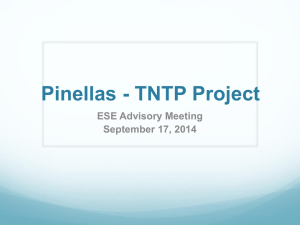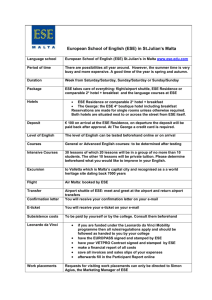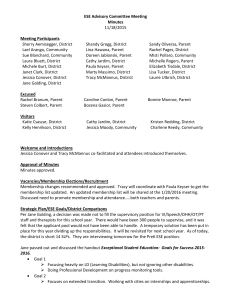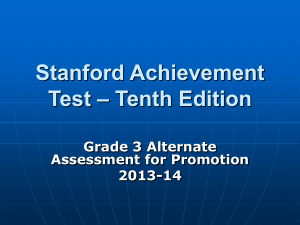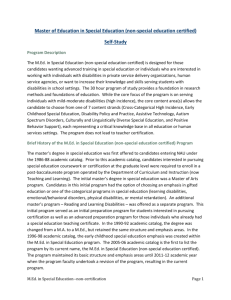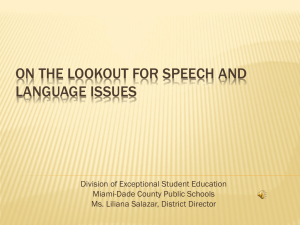Team Teaching Methods - Pasco County Schools
advertisement
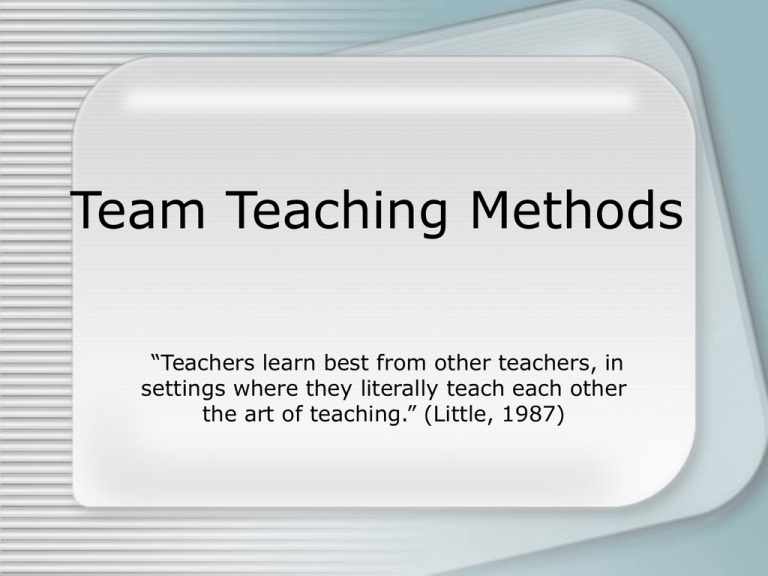
Team Teaching Methods “Teachers learn best from other teachers, in settings where they literally teach each other the art of teaching.” (Little, 1987) Team Teaching Settings • Provide abundant opportunities for individuals to share their collective and complementary skills and abilities toward better results. (Demming, 1986) • Allow teachers the opportunity to apply what they know and support each other as they implement and refine practice. (Schmoker, 2005) Why Are Team Teaching Methods Required? • Florida Statute requires all teachers who participate in team teaching, co-teaching or inclusion settings receive training in team teaching strategies. • Examples includes general education (GE) teachers who create teaching teams, GE and ESE teachers, or ESE teachers and support service personnel. Team Teaching • Pairing teachers for the purpose of staff development. • Pairing new teachers with veteran teachers. • Reducing turnover among new teachers. • Pairing teachers who are teaching out-of-field with teachers who are in-field. • Providing for more flexibility and innovation in the classroom. • Improving learning opportunities for students, including students who have disabilities. Who Should Apply Team Teaching Strategies? Strategies are appropriate for: • all teachers who plan together to create and provide instruction for students • teachers, administrators, and parents who work toward school and district goals • teachers who work with support service providers, instructional assistants, and paraprofessionals • any member of the educational community Activity What are some benefits of working in teams? Write down your thoughts What Teachers Say About Working in Teams • Provides collegial dialogue and support • Increases motivation to examine and improve practice • Helps improve instructional practice by sharing ideas, information, strategies, and materials • Develops leadership skills • Encourages self-reflection that challenges own assumptions, attitudes, and beliefs What Teachers Say About Working in Teams • Encourages reflection on current practice • Provides opportunity for help on daily tasks and projects • Provides opportunity for encouragement and emotional support • Provides opportunity for reassurance and support in and out of the classroom What About You? Share with a partner… Benefits you’ve experienced from working in a team situation Common Team Teaching Delivery Models • Learning Communities - GE and ESE • Team configuration with additional teacher (4 classrooms/ 5 teachers; GE or GE/ ESE) • Co-teach (GE/GE or GE/ESE) • Support Facilitation (GE/ESE) Collaborative Team Members The largest proportion of team teach configurations are a result of the ESE continuum of services. Co-Teachers: • ESE teachers • GE teachers • Specials, Elective, Enrichment or Vocational Teachers Support Facilitators: • • • • ESE teachers Support Services Personnel Speech/Lang Pathologists OT/PT, Deaf and Hard of Hearing, Vision Consultation Teachers: • ESE teachers • Support Services Personnel Special Education Delivery Models • Consult - monthly meetings with teachers • Learning Lab - “as needed” support in a separate room • Support Facilitation - weekly/daily in-class support • Co-teaching - daily in-class support • Parallel Class - daily separate class/regular standards • Self-contained - daily separate class or period/ regular or special standards Support Facilitation • Primary focus is meeting the needs of students with disabilities (students without disabilities can be included if grouped with students with disabilities) • Provides direct support for ESE students in the general education program • Allows for flexible grouping and scheduling of students and staff • ESE teacher can travel between classrooms to meet student needs • ESE teacher does not have to stay in the classroom for the entire class period • Collaboration should occur between the ESE and basic education teachers • Class size must meet requirements typically assigned to one teacher • Up to 1/3 of class roster can be ESE students Co-Teaching • Provides direct support for ESE students in the general education program • ESE teacher and GE teacher plan together and are responsible for delivering curriculum to all students • ESE teacher remains in the class for the duration of the period or every time that class meets • General education class size must meet requirements typically assigned to one teacher • 1/3 of total, made up of ESE students, can be added to class size requirement Team Teaching Strategies Collaborative Structures • One Teach/One Assist -Both teachers are present, but one takes the lead and the other observes or drifts around the room assisting students. • One Speak/One Add -One teacher takes the lead and the other adds or questions important points as they arise. • One Teach/One Chart - One leads discussion or lecture and the other one writes notes on board • Parallel Teaching -Teachers jointly plan instruction, but each delivers it to half of the class. Team Teaching Strategies Collaborative Structures • Station Teaching – content is divided and both teachers instruct separate groups, teaching different content. • Alternative Teaching – one teacher teaches a small group while the other teaches the large group. • Interactive/Team Teaching – teachers share instruction of whole group; activities are coordinated in one lesson. What Can I Do to Make My Team Teaching Experience Successful? Collaboration requires commitment on the part of each individual to a shared goal, demands careful attention to communication skills, and obliges participants to maintain equality throughout their interaction. (Friend,2000) Make Your Team a Success • Get to know your team or co-teacher • Clarify roles and responsibilities • Maintain effective communication • Focus on student learning • Make time for planning • Confront problems and disagreements Get to Know Your Team or Co-Teacher • Identify values and beliefs relating to your teaching style and classroom environment you consider indisputable • Share your philosophy of teaching • Discuss your goals for students’ level of achievement • Share your goals for professional development • Investigate interpersonal styles Clarify Roles and Responsibilities • Develop methods for holding one another accountable for agreed-on responsibilities and commitments. • Set up regular assessments and discussion of the team’s functioning in setting goals for improving relationships and effectively accomplishing tasks • Arrange for both or all teachers to be actively involved in instruction. • Allow teachers to change their collaborative structure (e.g., One Teach/One Assist) • Allow both teachers opportunity to demonstrate knowledge and skills Maintain Effective Communication • Develop interpersonal skills • Clearly communicate your ideas and feelings • Be an active listener • Conduct face-to-face interaction on a frequent basis "Seek first to understand, then to be understood." Stephen Covey (1990). Focus on Student Learning • Identify students’ curricular, social and behavioral needs • Discuss student outcomes and expectations • Discuss instructional practices • Create progress monitoring systems • Establish ongoing communication plan Make Time For Planning • Lack of time is identified most often as a key factor in teacher surveys • Work with administration to create time for planning and consultation • Create flexible schedules for ESE teachers (e.g.,altering planning periods on certain days of the week) Confront Problems and Disagreements • Incorporate conflict management skills • Agree on how you and your team or co-teacher will resolve problems • Be proactive in creating solutions to anticipated problems • Address problems as they arise, waiting may interfere with future relationship and negatively impact student learning • Ask for assistance to solve complicated problems Ticket Out the Door • One new thing I learned • Two things you will put into practice from this overview • A question I have
